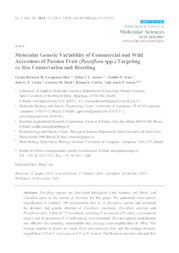Molecular genetic variability of commercial and wild accessions of passion fruit (Passiflora spp.) targeting ex situ conservation and breeding.
Molecular genetic variability of commercial and wild accessions of passion fruit (Passiflora spp.) targeting ex situ conservation and breeding.
Author(s): CERQUEIRA-SILVA, C. B. M.; SANTOS, E. S L; JESUS, O. N. de; VIEIRA, J. G. P.; MORI, G. M.; CORRÊA, R. X.; SOUZA, A. P
Summary: Passiflora species are distributed throughout Latin America, and Brazil and Colombia serve as the centers of diversity for this genus. We performed cross-species amplification to evaluate 109 microsatellite loci in 14 Passiflora species and estimated the diversity and genetic structure of Passiflora cincinnata, Passiflora setaceae and Passiflora edulis. A total of 127 accessions, including 85 accessions of P. edulis, a commercial species, and 42 accessions of 13 wild species, were examined. The cross-species amplification was effective for obtaining microsatellite loci (average cross-amplification of 70%). The average number of alleles per locus (five) was relatively low, and the average diversity ranged from 0.52 in P. cincinnata to 0.32 in P. setacea. The Bayesian analyses indicated that the P. cincinnata and P. setacea accessions were distributed into two groups, and the P. edulis accessions were distributed into five groups. Private alleles were identified, and suggestions for core collections are presented. Further collections are necessary, and the information generated may be useful for breeding and conservation.
Publication year: 2014
Types of publication: Journal article
Unit: Embrapa Cassava & Fruits
Keywords: Maracujá
Observation
Some of Embrapa's publications are published as ePub files. To read them, use or download one of the following free software options to your computer or mobile device. Android: Google Play Books; IOS: iBooks; Windows and Linux: Calibre.
Access other publications
Access the Agricultural Research Database (BDPA) to consult Embrapa's full library collection and records.
Visit Embrapa Bookstore to purchase books and other publications sold by Embrapa.

